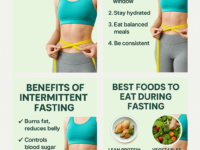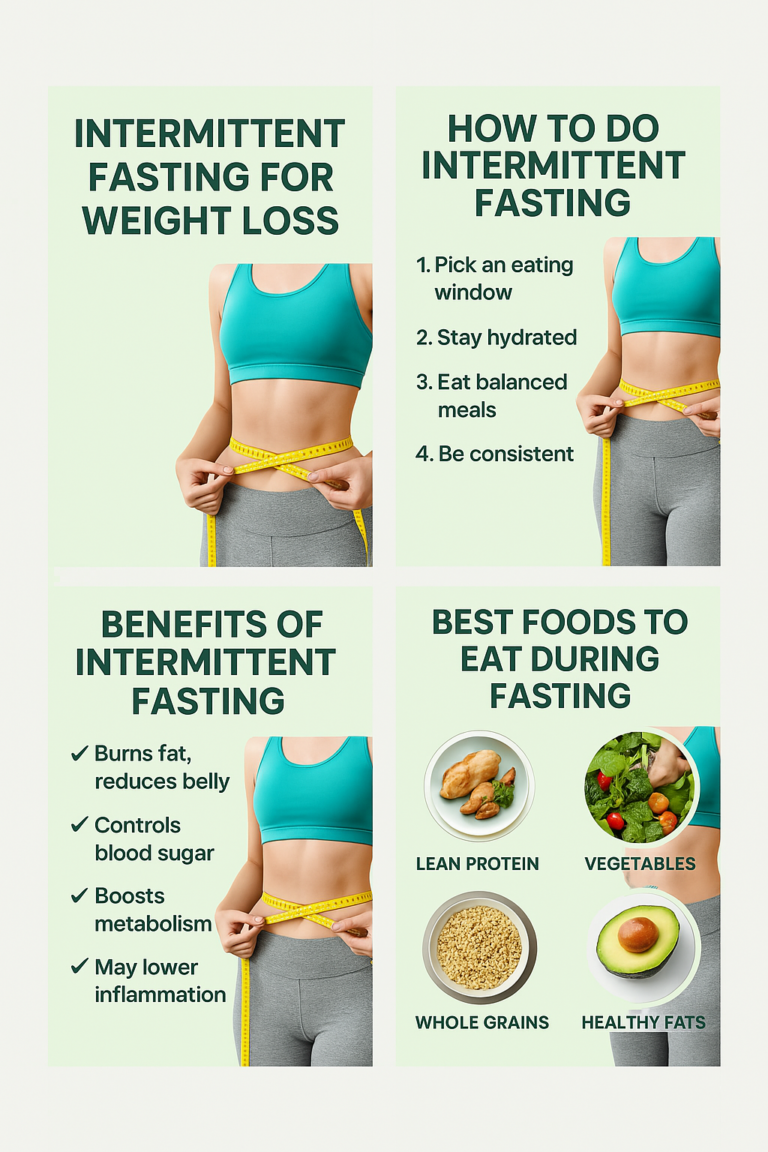Introduction: Intermittent fasting (IF) has taken the world by storm — and for good reason. It’s not a fad diet or a magic pill. It’s a simple, flexible eating pattern that can help you lose weight, burn fat, and even boost your overall health. The best part? You don’t have to give up your favorite foods.
Whether you’re brand new to intermittent fasting or you’ve heard about it and want to try it the right way, this ultimate guide will walk you through everything you need to know: how it works, benefits, types, tips, mistakes to avoid, and how to get started.
Table of Contents:
- What Is Intermittent Fasting?
- How Does It Help With Weight Loss?
- Types of Intermittent Fasting (Pick What Fits Your Life)
- Top Benefits Beyond Weight Loss
- Is Intermittent Fasting Safe?
- What You Can Eat and Drink During Fasting
- Tips for Getting Started (And Sticking With It)
- Mistakes to Avoid
- Sample Schedules (Real-Life Examples)
- Frequently Asked Questions (FAQs)
- Final Thoughts: Is IF Right for You?

- What Is Intermittent Fasting? Intermittent fasting isn’t about what you eat — it’s about when you eat. Instead of eating throughout the day, you cycle between periods of eating and fasting.
You already fast while you sleep. Intermittent fasting simply extends that fasting window and limits when you eat.
💡 Example: You eat all your meals between 12 p.m. and 8 p.m. and fast the rest of the time (this is called 16:8 fasting).
It’s not a diet, but a lifestyle that helps regulate hunger hormones and improves metabolism.
- How Does It Help With Weight Loss?
Intermittent fasting helps you lose weight in multiple ways:
- Reduces calorie intake naturally (fewer meals = fewer calories)
- Boosts metabolism by increasing norepinephrine and HGH levels
- Improves insulin sensitivity, making fat burning more efficient
- Helps control hunger and emotional eating
Research shows that people who follow intermittent fasting can lose 3–8% of body weight in 3–24 weeks — that’s powerful!
- Types of Intermittent Fasting (Pick What Fits Your Life)
Here are the most popular IF methods:
🔸 16:8 Method — Fast for 16 hours, eat during 8 hours. (Most popular and beginner-friendly) 🔸 14:10 Method — Fast 14 hours, eat for 10 hours. (Gentler version for beginners) 🔸 5:2 Diet — Eat normally for 5 days, restrict calories (500–600) on 2 non-consecutive days. 🔸 Eat Stop Eat — 24-hour fast once or twice a week. 🔸 OMAD (One Meal a Day) — You eat one large meal per day. Not recommended for beginners.
Start with 14:10 or 16:8 to build a habit.
- Top Benefits Beyond Weight Loss
✅ Fat Loss (especially stubborn belly fat) ✅ Better insulin sensitivity (helps prevent type 2 diabetes) ✅ Reduced inflammation and bloating ✅ Improved mental clarity and focus ✅ Increased energy and better digestion ✅ Simpler eating routines and fewer cravings ✅ May promote longevity and cellular repair (autophagy)
- Is Intermittent Fasting Safe?
In most cases, yes — but it’s not for everyone. IF is generally safe for healthy adults. However, you should avoid or speak with your doctor if you:
- Are pregnant or breastfeeding
- Have a history of eating disorders
- Take medications that require food
- Have diabetes or blood sugar issues
Always listen to your body. Start slow and adapt based on how you feel.
- What You Can Eat and Drink During Fasting
✅ Allowed During Fasting:
- Water (plain, sparkling, lemon slice is OK)
- Black coffee (no sugar or cream)
- Herbal tea (unsweetened)
- Apple cider vinegar (diluted)
- Electrolytes (no calories)
❌ Avoid:
- Any drinks with calories (juice, milk, soda)
- Gum with sugar
- Bone broth or protein shakes (save for eating window)
During the eating window, focus on whole foods:
- Protein: Eggs, fish, chicken, beans, tofu
- Fiber: Veggies, fruits, oats, legumes
- Healthy fats: Avocados, nuts, olive oil
- Tips for Getting Started (And Sticking With It)
🕒 Start Gradually — Begin with a 12:12 or 14:10 method and work up to 16:8 💧 Stay Hydrated — Water is your best friend during fasts 🍽️ Break Your Fast Gently — Choose protein + fiber to avoid sugar crashes 🥣 Plan Your Meals — Prepping makes it easier to stick to your window 🛏️ Get Enough Sleep — Lack of sleep can spike hunger hormones 👥 Stay Accountable — Track your fasts or join a support group
- Mistakes to Avoid
🚫 Overeating during eating windows 🚫 Breaking your fast with sugary foods or drinks 🚫 Fasting too aggressively too soon 🚫 Not eating enough nutrient-rich foods 🚫 Ignoring hydration and sleep 🚫 Comparing your journey to others
- Sample Schedules (Real-Life Examples)
📅 Example #1: 16:8 (Busy Working Mom)
- 12:00 PM: First meal (eggs, avocado toast)
- 3:00 PM: Snack (Greek yogurt, berries)
- 7:30 PM: Dinner (chicken, rice, veggies)
- Fast from 8 PM to 12 PM next day
📅 Example #2: 14:10 (Beginner Friendly)
- 10:00 AM: First meal (smoothie, oatmeal)
- 1:30 PM: Lunch (salad with protein)
- 6:00 PM: Dinner (stir fry, brown rice)
- Fast from 7 PM to 10 AM next day
- Frequently Asked Questions (FAQs)
❓Will I lose muscle with intermittent fasting? Not if you eat enough protein during eating windows and don’t fast excessively. Resistance training also helps preserve muscle.
❓Can I drink coffee during a fast? Yes, black coffee is fine. Just avoid sugar, cream, or milk.
❓How long does it take to see results? Many people see changes in energy, digestion, and appetite within the first week. Weight loss becomes noticeable in 2–4 weeks with consistency.
❓Can I combine intermittent fasting with keto or low-carb? Yes, many people do. IF works with most eating styles — just keep calories in check.
- Final Thoughts: Is IF Right for You?
Intermittent fasting isn’t a magic solution — but it is a powerful, sustainable tool for weight loss and better health. It simplifies your eating, helps you control hunger, and gives your body a chance to reset and heal.
If you’re tired of complicated diets and strict meal plans, IF might be exactly what you need.
Start small, stay consistent, and listen to your body. Your weight loss journey can be smart, effective, and freeing — and intermittent fasting might just be the missing piece.
Ready to give it a try? Let us know in the comments which IF method you’ll start with!





0 Comments